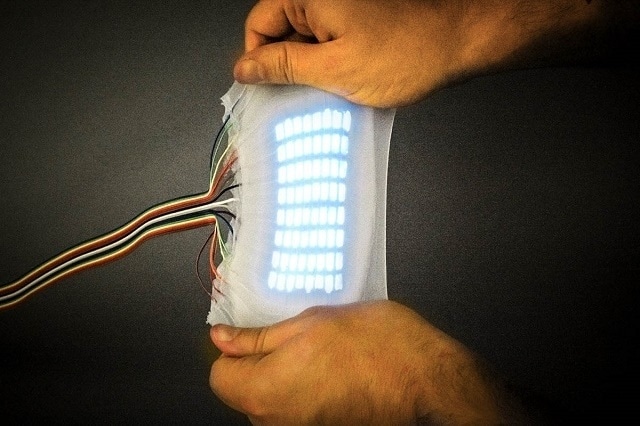Mar 7 2016
A group of graduate students from Cornell University have developed a unique electroluminescent skin that can be stretched to almost six times its actual size, but still produces light even under increased amounts of strain. This latest breakthrough holds the potential to transform a wide range of industries, including health care, electronic communication, and transportation.
 The research group of Rob Shepherd, assistant professor of mechanical and aerospace engineering, has developed a highly stretchable electroluminescent skin capable of stretching to nearly six times its original size while still emitting light. The group’s work is documented in a paper published online March 3 in the journal Science. Credit: Chris Larson
The research group of Rob Shepherd, assistant professor of mechanical and aerospace engineering, has developed a highly stretchable electroluminescent skin capable of stretching to nearly six times its original size while still emitting light. The group’s work is documented in a paper published online March 3 in the journal Science. Credit: Chris Larson
The study was headed by Rob Shepherd, an assistant professor of mechanical and aerospace engineering. An autonomous vehicle integrated with a data display interface that can be modified to suit the needs of passengers, or a health care robot that shows the pulse and temperature of a patient and responds to a patient’s mood are considered to be futuristic ideas even in this time of next generation electronics, like smartphones and other similar devices.
This material can stretch with the body of a soft robot, and that’s what our group does. It allows robots to change their color, and it also allows displays to change their shape.
Rob Shepherd, Assistant Professor, Mechanical and Aerospace Engineering, Cornell University
Compared to the earlier tested stretchable displays, the newly developed hyper-elastic light-emitting capacitor, also known as HLEC, is capable of withstanding increased amounts of strain. The HLEC includes transparent layers of hydrogel electrodes that accommodate an insulating dielectric elastomer sheet. When the elastomer is rolled, expanded, and deformed, it changes capacitance and luminance.
A demonstration of electroluminescent skin
We can take these pixels that change color and put them on these robots, and now we have the ability to change their color. Why is that important? For one thing, when robots become more and more a part of our lives, the ability for them to have emotional connection with us will be important. So to be able to change their color in response to mood or the tone of the room we believe is going to be important for human-robot interactions.
Rob Shepherd, Assistant Professor, Mechanical and Aerospace Engineering, Cornell University
In addition to emitting light under increased strain, amounting to more than 480% its original size, the HLEC can also be incorporated in a soft robotic system. In order to develop a crawling soft robot the team combined three 6-layer HLEC panels, with the bottom two layers acting as pneumatic actuators and the top four layers serving as the light-up skin. The chambers were deflated and inflated in an alternate way, and the resulting curvature produced a rolling “walking” motion.
Shepherd acknowledged the contributions of four graduate students, Bryan Peele, Sanlin Robinson, Shuo Li and Chris Larson, for developing this unique idea for the material. Except for Li, others attended Shepherd’s Rheology and Processing of Soft Materials class way back in spring 2014. It is during this time that the idea for the material was conceptualized.
They would say something like, ‘OK, we have a single pixel that can stretch 500 percent in length.’ And so I’d say, ‘That’s cool, but what is the application for it?’ And that’s the biggest thing – you can have something cool, but you need to find a reason to use it.
Rob Shepherd, Assistant Professor, Mechanical and Aerospace Engineering, Cornell University
Apart from the four graduate students, all other members of the Shepherd Group also contributed towards the study. These included Barbara Mazzolai, Lucia Beccai and Massimo Tottaro of the Italian Institute of Technology’s Center for Micro-BioRobotics, a well-known expert in robotics study. Shepherd initially met Mazzolai and Beccai at a conference a couple of years ago, and this study marks their first collaboration.
The paper titled, “Highly Stretchable Electroluminescent Skin for Optical Signaling and Tactile Sensing,” has been reported in the Science journal.
While Shepherd admitted to “not being very fashion-forward,” wearable electronics is yet another promising application for the novel material. In current wearable technology, hard electronics have to be placed onto a soft base, such as a Fitbit or an Apple Watch, but this latest discovery holds promise for designing advanced devices that completely conform to the shape of a wearer.
You could have a rubber band that goes around your arm that also displays information. You could be in a meeting and have a rubber band-like device on your arm and could be checking your email. That’s obviously in the future, but that’s the direction we’re looking in.
Chris Larson, Graduate Student, Cornell University
In addition to the electroluminescent skin, the team has also created a stretchable and lightweight material with a memory foam consistency, which could possibly be used in artificial organs, prosthetic body parts, and soft robotic systems.
The study was funded by two grants from the National Science Foundation as well as a grant from the Army Research Office, a 2015 award from the Air Force Office of Scientific Research.